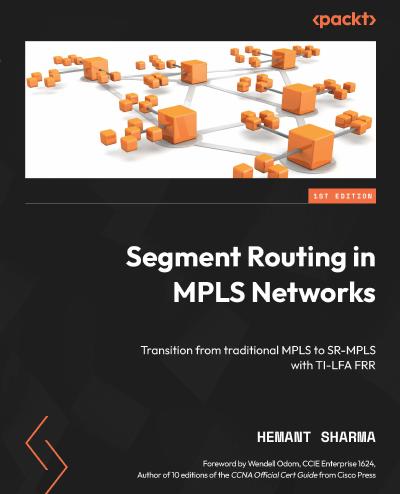English | 2024 | ISBN: 978-1836203216 | 292 Pages | PDF, EPUB | 13 MB
Unlock the power of segment routing (SR-MPLS) and fast reroute (FRR) techniques through immersive hands-on labs to revolutionize your understanding and implementation of next-gen MPLS protocol
Key Features
- Carry out practical labs to thoroughly grasp and execute MPLS, SR-MPLS, and FRR techniques
- Master SR-MPLS and LDP interoperability for seamless integration and efficient network operation
- Implement TI-LFA FRR methods for seamless SR-MPLS deployment in production
In this book, you will learn about segment routing (SR), a cornerstone of modern networking, and topology-independent loop-free alternate (TI-LFA), with hands-on labs to hit the ground running. Written by a key contributor to global segment routing multiprotocol label switching (SR-MPLS) network designs, this book makes learning SR-MPLS both accessible and insightful.
The book offers an extensive learning path, taking you from a traditional MPLS network using the label distribution protocol (LDP) to a modern SR-MPLS network using SR, and provides a holistic view of their interworking. You’ll also explore TI-LFA fast reroute protection scenarios, and find out how SR-MPLS strengthens network reliability with its source routing paradigm. Using intermediate system–to–intermediate system (IS-IS) as the foundational link-state routing protocol, the chapters ensure that you get a clear understanding of both SR and IS-IS. Following a consistent network topology throughout, this book enables smooth transitions between scenarios, helping you master the technical concepts without distraction.
By the end of this book, you’ll have a solid grasp of MPLS, SR-MPLS, and TI-LFA fast reroute techniques, ready to tackle real-world networking challenges with confidence.
What you will learn
- Gain a complete understanding of MPLS and its role in network infrastructures
- Develop practical skills to implement SR-MPLS using Cisco IOS-XRv9k and real-life use cases
- Acquire hands-on experience with MPLS networks using the IS-IS and LDP protocols
- Orchestrate the gradual transition from traditional MPLS to SR-MPLS networks and manage their interworking
- Master fast reroute techniques in SR-MPLS networks, including TI-LFA, for efficient traffic rerouting
- Implement path protection methods to ensure network resilience and stability
Resolve the captcha to access the links!
